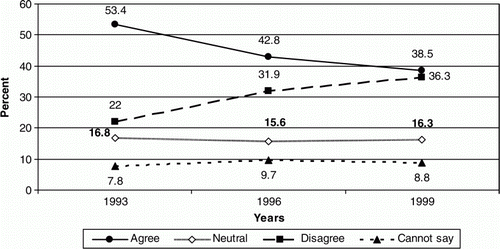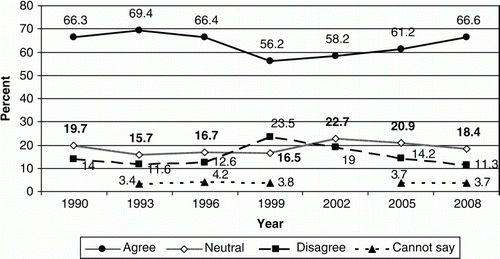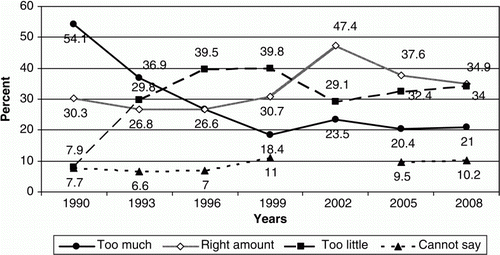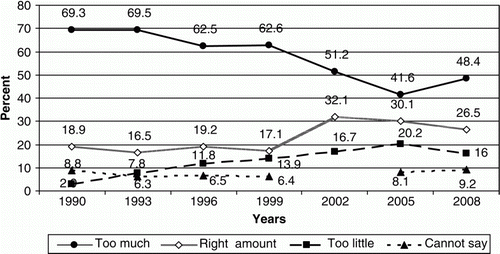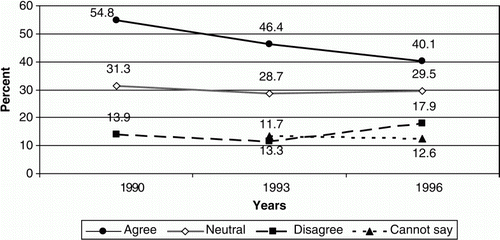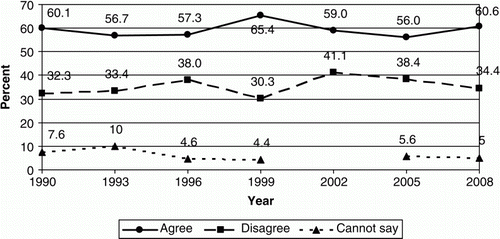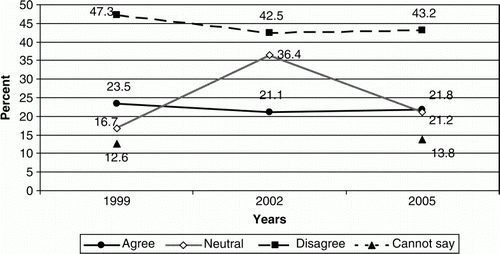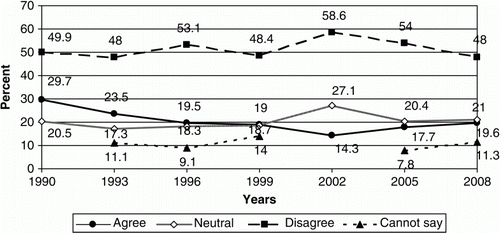Abstract
Did significant policy shifts in employment relations in the 1990s lead to equally large changes in the attitudes of New Zealanders towards employment relations? Have policy modifications made since 1999 further shaped public perceptions? This paper explores the role of policy feedback in influencing public opinion towards employers and unions and towards government responsibility for jobs and wages. Using data from New Zealand public opinion surveys, most notably the New Zealand Election Study (1990–2008), the paper finds some evidence that policy feedback has occurred in the employment relations arena, but the impact is not as strong or consistent as we might expect. As such, New Zealanders do not completely endorse the ‘there is no alternative’ arguments of neoliberalism, but they do not have an overwhelming desire to return to Keynesian demand-management employment policies.
Employment relations in New Zealand were radically transformed in the early 1990s when centralized wage bargaining was dismantled alongside rapid economic deregulation. This regime was modified from 1999, but by no means represented a return to the ‘wage earners’ welfare state’. This paper asks: did such significant policy shifts lead to an equally large change in the attitudes of New Zealanders towards employment relations? Influenced by historical institutionalism, the paper explores the role of policy feedback, where policy exerts an influence over sources of welfare state support and the strategies of actors seeking to shape policy (Pierson Citation1993).
Research has largely focused on how policies affect organized interest groups or political elites but Pierson (1993) highlights the need to pay attention to the effects of policy feedback on the mass public. He argues that the resources and incentives provided by policies can shape patterns of behaviour (resource effects) and can convey meanings and information (often mediated by the media) to citizens (interpretative effects). Policies thus do more than simply generate electoral reward or punishment, but can change the basic features of the political landscape (Soss & Schram Citation2007). Pierson (Citation1993) believes mass public effects are most likely if a policy is (a) visible (members of the public experience some discernible outcome, leading them to inquire about its cause); (b) traceable (they link policy outcomes to some government action); and (c) proximate (the policy has a tangible presence either in people's immediate lives or they hear about its effects through the networks to which they belong). Lock-in effects can also be created if policies encourage individuals to make significant investments that are not easily reversed and/or include strong incentives to adopt prevailing or anticipated standards.
Using data from New Zealand public opinion surveys, this paper explores the role of policy feedback in employment relations. After first hypothesizing what effects might have emerged from the shifting terrain of employment relations policy, it uses the New Zealand Election Study (NZES) data to track trends in attitudes over an 18-year period (1990–2008). With over 1000 individuals responding to a relatively stable set of questions each cycle, this data set is comprehensive and reliable. It is supplemented with the less regular New Zealand Values Studies (NZVS – Perry & Webster 1993; Perry unpubl. data), the one-off New Zealand Attitudes and Values Survey (NZAVS – Royal Commission on Social Policy 1988) and two Heylen Research Centre (HRC Citation1988, Citation1991) polls. The paper then analyses attitudes towards employers and unions before considering those towards government responsibility for jobs and wages. It concludes that changes in employment relations policy do appear to have had an impact on public attitudes but not necessarily to the degree or with the consistency we might expect.
Employment relations policy: promoting public acquiescence or resistance?
New Zealand's shift from Keynesianism to neoliberalism is commonly characterized as radical and transformative (Kelsey Citation1995; Starke Citation2008). In employment relations, there was certainly a rapid shift away from a ‘wage-earners’ welfare state’, which prior to the mid-1980s integrated four key policy planks (Castles, Citation1996). First, a system of occupational ‘awards’ determined wages and governed employment relations, with most workers represented by their unions in highly institutionalized processes of negotiation with employers and the state. This ensured a decent standard of living for most families (Pacheco Citation2007; Ramia & Wailes Citation2006). Second, industry protections and subsidies were used as the main economic incentive for employers to maintain labour conditions. Third, immigration controls discouraged an influx of migrants who would accept lower than standard wages and working conditions. Finally, a ‘residual’ welfare state offered a last-resort safety-net for those whose living standards were not otherwise protected (Castles Citation1996; Ramia & Wailes Citation2006).
The dismantling of this policy framework began under the Fourth Labour government (1984–90) which rapidly deregulated finance and trade and took New Zealand from being one of the most to one of the least protected economies in the world. Labour also began corporatizing and privatizing the public sector and abandoned Keynesian full employment policies, increasing already historic levels of unemployment. However, given its historical ties with the trade union movement, Labour was hesitant to radically reform the labour market, making only minor changes in the 1987 Labour Relations Act (Ramia & Wailes Citation2006; Waldegrave et al. Citation2003). The newly elected National government (1990–99) was far less reticent, using the 1991 Employment Contracts Act (ECA) to completely disassemble the wage earners’ welfare state. With voluntary arbitration already in place in the private sector since 1984, the ECA went further by decentralizing wage bargaining and replacing collectivism with voluntarism and individualism (Roper Citation2005). This offered employers greater flexibility and total employment grew substantially (by 18.4% between 1990 and 2000). But the working age population also increased by 15.1% over the same period (Harré Citation2010) and much of the employment growth was in part-time, casual and temporary work (Spoonley Citation2004).
More significantly, the ECA sharpened an existing decline in union membership, which dropped from almost 50% of the total employed labour force in 1990 to just over 24% in 1996 (Blumenfeld Citation2010). Big unions were reduced from 28 to 12 between 1991 and 1999, with 90% of union members by 2000 found in four sectors: public and community services; manufacturing; transport and storage; and financial and business services (Waldegrave et al. Citation2003). Furthermore, the ECA brought immediate and significant wage losses. In the five years after 1995, average real wages increased by only 0.6%, with significantly lower outcomes for blue collar, customer-service and sales employees than professionals. Low wage growth, combined with unsatisfied demand for longer hours of work, meant that those suffering most from the restructuring of the public and manufacturing sectors in the 1980s gained little or nothing during the 1990s (Harré Citation2010; Waldegrave et al. Citation2003). These effects were worsened by benefit cuts and a tightening of eligibility in 1991, then increasing levels of work-related obligations for the unemployed as the decade progressed (Humpage & Craig Citation2008; Ramia & Wailes Citation2006).
There is some evidence that the speed and extent of the neoliberal reforms provoked public resistance, rather than acquiescence. Larner (Citation2000) argues power is not constituted and exercised exclusively within the state, for hegemony is only achieved through an ongoing process of contestation and struggle that ultimately changes political thought and argument. Given a lack of consensus about employment relations in New Zealand (Rasmussen & Anderson Citation2010), the ECA's high degree of visibility and traceability provoked considerable protest. For instance, up to half a million New Zealanders were involved in strikes, stopwork meetings, rallies and marches during an April 1991 Week of Action. Although strike activity declined to its lowest level since the 1930s immediately after the ECA was introduced, the 1990s saw continued and successful social action from students, Maori, teachers and nurses and the Seafarer's Union (Roper Citation2005).
Nevertheless, the ECA had strong potential to produce a lock in effect. It reduced the proximity of unions, with most workers now employed on individual contracts and younger ones having no personal experience of union membership. A lock in effect may also be associated with the considerable extension of individual employee rights, through personal grievance processes established in 1991, the Health and Safety Act 1992, the Human Rights Act 1993 and the Privacy Act 1993 (Rasmussen et al. Citation2006; Walker Citation2007). This paradoxical ‘regulatory avalanche’ (Rasmussen & Lamm Citation2005) may have mediated public perception of the reforms, serving to be more visible and proximate to many individuals than the more complex, longer-term negative impacts the ECA had on New Zealand workers.
We should also not underestimate the power of the interpretative effects resulting from the pro-business political rhetoric, both from the government and influential organizations such as the Business Roundtable, during the 1990s (Roper Citation2005). Neoliberalism is not just a set of policies but also acts as a powerful ideological tool. Larner (Citation2000) argues that, in drawing upon a number of traditions that sit in tension with each other, neoliberalism makes sense to people and groups from a range of social positions. This ability of neoliberalism to appeal to almost everyone in some way may have encouraged public support for the ECA and the business sector, while diminishing support for trade unions and government intervention in employment relations after 1991.
If policy matters, we might further anticipate a shift in public opinion after the newly elected Labour-coalition government (1999–2008) introduced the Employment Relations Act (ERA) 2000. This softened some of the restrictions on union membership found in the ECA; notably, employees covered by a collective agreement were now required to join a union that was a party to that agreement. Employer groups argued some changes introduced major constraints on their behaviour and created a bias towards collective bargaining and union membership, but the ERA's significance was diluted by maintaining individual agreements for employees whose job could be covered by a collective agreement (Walker Citation2007). This binding together of union membership and collective bargaining saw an initial drop in collective bargaining coverage (Waldegrave et al. Citation2003). The ERA also set out minimum requirements consistent with good faith bargaining but a lack of clarity on this issue saw a detailed explanation of good faith added to the ERA in 2004. This amendment also explicitly tackled ‘free-riding’ by restricting collective agreement coverage to union members (Rasmussen et al. Citation2006). Both changes emerged only after two years of contentious debate, which saw the National Party predicting a strong and lasting detrimental effect on the economy and promising to repeal all the amendments (Walker Citation2007).
Despite such predictions, the ERA's impact was surprisingly low on both business confidence and union growth (Walker Citation2007). The Department of Labour (DOL Citation2009) reports that, while union membership increased slightly under the ERA, union density was static at around 17% and membership remained concentrated in the public sector (Blumenfeld Citation2010). Moreover, the proportion of employed people covered by collective agreements (around 15% in 2008) has declined or remained static since 2001 (DOL 2009).
Rasmussen and Lamm (Citation2005) believe these trends may be partly explained by the substantial gains delivered to workers post-1999 through government policy. These included the introduction of paid parental leave, a fourth week of annual leave and small but regular increases in the minimum wage. Skills shortages also featured extensively in media in the 2000s, followed by a marked increase in public and private training investment and changes to improve retention of existing staff, such as the right to request changed working hours and improved worker conditions around rest breaks and infant feeding (Burton Citation2010; Rasmussen et al. Citation2006). Such government-led initiatives may have discouraged many workers from seeing any necessity in union membership, contributing to what Rasmussen and Lamm (2005, p. 479) call ‘an embedded culture of workplace bargaining and individualised employment relationships in New Zealand’. However, Waldegrave et al. (Citation2003) stress that the ERA was introduced in the context of a comparatively strong labour market, which may have weakened the perceived need for collective agreements amongst employees. Significant growth in self-employment arrangements also meant many workers were not covered by the ERA (Spoonley Citation2004), while unions had fewer resources to promote themselves and their services (Harré Citation2010).
Prior to the 2008 election, the National Party publicly moved away from its earlier promises to repeal the ERA but its continued desire to make bargaining processes less prescriptive and to better meet the demands of businesses was evident in legislation passed once National came to power in late 2008. This allowed small (later all) businesses to sack employees within 90 days of being hired, without recourse to personal grievance processes (Burton Citation2010). This sat in tension with National's relatively generous redundancy and wage-supplement packages for those affected by the recession, which implied the government was willing to take some responsibility for jobs in a poor economy (Key Citation2008). While these changes occurred after the most recent data analysed in this paper was collected at the November 2008 election, National's shifting position on employment relations was already evident. Indeed, the most notable (although potentially ‘invisible’) feature of the election campaign was that radical, sweeping employment relations reforms were not high on the political agenda or promised as a ‘solution’ to wider economic and social problems for the first time in nearly three decades (Rasmussen & Anderson Citation2010).
This policy history leads us to predict the ERA would have lesser impact on public opinion than the ECA, doing little to halt diminishing support for unions and government intervention in employment issues and growing support for business, especially since the latter actively and publicly aired concerns about the future of business under the Labour-coalition through the early 2000s (Roper Citation2005). Although the ERA only tinkered with, rather than transformed, neoliberal economic agendas, the union movement supported it against such business opposition. There were divisions within Labour and trade unions about the legislation (Harré Citation2010), but this suggests a significant lock in effect had already occurred. The level of action demonstrated by other social movements also fell, although Roper (2005) believes this was partly because many people wanted to give Labour time to prove itself. Furthermore, the ERA had poor ‘visibility’, at least compared to government initiatives aiming to improve wages and conditions during the 2000s. This may have led to diminishing public support for unions but a continuing or strengthening belief that government is responsible for employment.
In assessing policy feedback effects, it is important to acknowledge that public attitudes towards employment relations are shaped not only by policy but also by the broader social and economic shifts affecting the labour market in New Zealand over the last two decades. Notably, there is evidence that economic conditions, particularly unemployment rates, can influence voting behaviour and public opinion (Blekesaune Citation2007; Brook Citation1998). There is also a possibility that the same shifts in context could lead to the same survey questions being interpreted differently over time. For brevity's sake, this paper will explicitly analyse only the potential impact of policy but where such factors seem likely to be important, acknowledgement is made in the following two sections which present public opinion data on employment relations.
Employers and unions
The best way to investigate whether the ECA, which radically and visibly transformed the relationship between workers and employers, had a lock in effect is to consider an NZES question which specifically asks about this legislation. shows that the number of respondents agreeing ‘the Employment Contracts Act should be repealed’ fell steadily from 53.4% in 1993 to 38.5% in 1999. The number disagreeing followed the reverse trend, with 22% in 1993 growing to 36.3% in 1999.
These findings suggest that New Zealanders came to accept the ECA over time, despite considerable protest about it in the early 1990s. This may be because gains in individual employee rights were more visible to workers than the lost benefits of belonging to a union or simply because the TINA (there is no alternative) arguments of the National government dominated political discourse and eventually started to influence public opinion. However, in 1989, 51.1% of NZVS respondents favoured ‘abolishing compulsory unionism’, one of the main components of the ECA introduced two years later. This suggests New Zealand opinion on this issue was more evenly divided than the NZES data on repealing the ECA suggests before the legislation was publicly debated in the early 1990s.
This finding sits in tension with , which shows that a substantial majority (around 66%) of NZES respondents agreed ‘trade unions are necessary to protect workers’, in both 1990 and 2008. However, the number of ‘agree’ responses peaked at 69.4% in the mid-1990s before dropping to an all-time low (56.2%) in 1999, then grew steadily again through the 2000s. The number of respondents disagreeing with the statement ranged between 12% and 14% during the 1990s, before rising to 23.5% in 1999 then dropping slowly to 18.4% in 2008.
Thus the high visibility of the ECA and public resistance to it seem to have initially encouraged more NZES respondents to agree trade unions were necessary during the early-to-mid 1990s. By the end of the decade, support had diminished and, even if over half the respondents still believed this to be true, continuing majority support for unions as necessary did not generally translate into union membership, which increased only marginally after the ERA was enacted. Employees may have been less aware of, and had lower demand for, union services. But the NZES data suggest that aggregate public opinion was also shaped by the likelihood of change under the government in power at the time. Although a lock in effect may have occurred over time, an upsurge in support for the necessity of unions after 1999 suggests that the Labour-coalition's rhetoric around the ERA raised hope that unions might gain or needed more power. That such support continued through the 2000s suggests the ERA did not satisfy the public, possibly because its minor improvements were not visible (when improved minimum wages and conditions resulted from government intervention) or it did not have any obvious impact upon their lives. However, without specific questions being asked about the ERA in the NZES, we can only hypothesize about public attitudes to it.
shows the number of respondents agreeing ‘trade unions in New Zealand have too much power’ dropped substantially from 54.1% to 18.4% between 1990 and 1999, before settling around 21%–23% in the 2000s. The number of respondents believing trade unions have ‘too little’ power followed more or less the opposite trend, beginning at only 7.9% in 1990 before peaking at 39.8% in the late 1990s, then dropping to 29%–35% in the 2000s. Those who thought trade unions had about the ‘right amount’ of power stayed fairly steady (26%–30%) during the 1990s but then rose to 47.4% in 2002 before dropping back to 34%–37% in following years. The number of respondents offering a ‘cannot say’ response also rose a little (from 6%–7% in the 1990s to 9%–11% from 1999 onwards).
Overall, suggests the public knew the legislation was about reducing union power: both the largest drop in responses agreeing that unions had ‘too much’ power (24.3%) and the largest increase in ‘disagree’ answers (21.9%) occurred between 1990 and 1993, implying this significant policy shift changed public opinion. That the distance between the number of ‘too much’ and ‘too little’ responses was at its narrowest and the number of ‘right amount’ responses was highest in 2002 again indicates New Zealanders had high hopes for the ERA. The drop in both ‘too little’ responses and ‘right amount’ responses after this time implies these hopes were only partly met. This may be due to the moderate nature of the ERA and its impact and/or to the fact that wage and conditions improved as a result of government initiatives rather than direct union negotiations.
The NZES does not ask respondents about employers specifically, but rather whether they think ‘big business in New Zealand has too much power’. ‘Big business’ clearly represents only some employers, but responses to this question give us some idea of public perceptions towards them. shows that between 1990 and 1999, a substantial majority of NZES respondents (62%–69%) agreed big business had ‘too much’ power, while only a significant minority (41%–48%) did so in the mid-to-late 2000s. Overall, ‘too much’ responses declined by almost 21% across the entire period but most significantly between 1993 and 1996 (by 7%), 2002 and 2005 (9%) and 1999 and 2002 (11%), before a 6.8% increase in 2008. The number of New Zealanders perceiving big business to have ‘too little’ power was at an all time low of 2.9% in 1990 but grew steadily to just over 20% in 2005, before dropping to 16% in 2008. The biggest jumps in support were between 1990 and 1993 (almost 5%) and 2002 and 2005 (3.5%). In contrast, the number who thought big business had about the ‘right amount’ of power hovered between 17% and 19% until 1999, before rising sharply to 32.1% in 2002 then dropping slightly to 26.5% in 2008.
These findings suggest perceptions of big business power came closer to public expectations in the 2000s, when some of the most pro-business aspects of the ECA were modified by Labour-coalition governments. While presumably the drop in the number of respondents agreeing big business had ‘too much’ power between 1999 and 2002 was related to the ERA's attempts to weaken employer dominance, the smaller decline in support between 1993 and 1996 is less easily explained. Other survey data (see HRC Citation1988, Citation1991; Perry & Webster Citation1993) suggest that early concerns about corporatization and privatization of the public sector, particularly when government organizations were sold to foreign investors, diminished over time and this may have impacted upon attitudes towards the power of big business during the mid-1990s.
A further NZES question asked whether ‘government should regulate business less to help solve New Zealand's economic problems’, bringing into the equation government's role in mediating the relationship between workers and employers and in managing the economy. Although only 1990–96 data are available, suggests a significant and steady drop in affirmative support for less regulation of business from 54.8% to 40.1%. The number of respondents disagreeing that business should be regulated less also decreased slightly (by 2.2%) between 1990 and 1993 before rising by 6.2% in 1996.
In summary, by 1996 New Zealanders appeared less likely to accept deregulation as a means of solving economic problems, possibly because economic conditions improved as the decade progressed and/or because the impact of such deregulation became clearer. However, NZVS data (Perry & Webster Citation1993; P. Perry unpubl. data) suggests public support for ‘tighter government regulation of big companies and multinationals’ remained significant and steady (53%–55%) between 1989 and 2004, then rose significantly (to 63.6%) in 1993. This may again be a reaction to the rapid process of selling state assets to foreign investors that was highly visible to the public at this time, given the ensuing job losses would have affected the personal lives of many workers. The increasing media profile of pro-business think tanks, such as the Business Roundtable, in advocating certain policies may also have had an interpretative effect.
Government responsibility for jobs and wages
Asides from regulating business for the benefit of the broader economy, government can also play a role in protecting jobs and wages. shows that a majority of respondents (just over 60%) agreed ‘government should take responsibility to provide jobs for everyone’ in 1990 and 2008, with mild fluctuations (56%–65%) in the intervening years. ‘Disagree’ responses ranged only between 30% and 41% but rises came at the same time ‘agree’ responses diminished. The percentage of respondents who said ‘cannot say’, however, was noticeably higher in 1990 and 1993 (7%–10%) before dropping to 4.4% then rising slightly in 2005 and 2008 (to around 5%). Incomplete data make it difficult to discern a clear pattern, but the number of ‘cannot say’ responses appears to have decreased as more respondents disagreed with the statement.
Overall, this indicates that most New Zealanders continued to believe government has responsibility regarding jobs, despite ongoing rhetoric promoting (and implementing) deregulation and ‘smaller government’. When a similar question was asked in the NZAVS, 86% agreed that ‘all should have a job who wants one’, suggesting a significant drop in support between 1988 and 1990 (RCSP Citation1988). That ‘agree’ responses in the NZES drops after this year, then rises in 1999, drops through the most in the 2000s and increases again in 2008 indicates support may be mildly associated with anticipation of a change of government.
Import tariffs and controls that protect domestic industries are one way government can try to ensure job availability. By the mid-1990s, the abolition of these, combined with corporatization/privatization and the ECA, had a negative impact on unemployment (Roper Citation2005). That this policy lever is no longer widely used is evident in the changed wording of the NZES question: respondents were asked if they supported or opposed ‘increasing import controls’ in 1990 and 1993, ‘import controls’ in 1996 and a policy to ‘introduce import controls’ from 1999. In all cases, respondents were asked about import controls in the context of ‘solving New Zealand's economic problems’, which may also have shaped their view of them. When an HRC (1991) poll, for instance, asked respondents how important they considered various activities for improving ‘New Zealand's standard of living’, 65% said ‘increase tariffs’ and only around 35% wanted to ‘reduce tariffs’. This suggests higher support for both propositions than found in the NZES.
Even given these interpretative problems, still suggests public support for import controls declined overall (from 50.4% to 42.3% between 1990 and 2008). This is despite a sharp rise (by 7.6%) in support between 1996 and 1999 and a weaker rise (4%) between 2005 and 2008. It is possible the latter represents a longer-term increase in support: that the highest number of ‘agree’ responses were in 1990, 1999 and (to a lesser extent) 2008 indicates that the public is more willing to support import controls when a change of government seems likely. Interestingly, however, the number of respondents disagreeing with import controls also decreased slightly over the long term (from 26.7% to 24.5%), while the number who were ‘neutral’ increased (from 22.9% to 24.5% but with a sharp rise to 33.6% between 1999 and 2002). A small proportion of New Zealanders may thus have softened their views over time without necessarily becoming full advocates of import controls.
Overall, a significant minority of New Zealanders remained in favour of import controls long after they ceased to be a significant part of economic policy. This could be due to poor public knowledge on this issue, questioning the role policy plays in shaping public opinion. However, it is possible NZES responses were influenced more by broader public beliefs about the role of the government to protect workers than the specifics of this particular policy tool (Dean & Melrose Citation1999; Stimson 2004).
Government may also use minimum wage legislation to regulate wage levels in the labour market as a means for income protection (Pacheco Citation2007). The NZES did not ask a relevant question until 1999, but its focus on the proposition ‘minimum wages reduce the creation of new jobs’ reflects political debates during the 1990s about whether minimum wages reduce employment because they inhibit market competitiveness (Pacheco Citation2007). shows that a significant minority (42%–47%) of respondents disagreed minimum wages reduce job creation between 1999 and 2005, but fewer did so by 2005. A smaller minority (21%–23%) agreed that minimum wages reduce new jobs and, although these responses were steadier than ‘disagree’ answers, they followed a similar trend of dropping slightly (by almost 2%) between 1999 and 2005. ‘Neutral’ responses, however, grew by almost 20% between 1999 and 2002, before dropping almost as rapidly (by 14.6%) in 2005.
These latter findings suggest many New Zealanders found it difficult to respond to this question, either due to inadequate knowledge or because other factors can also affect job creation. Indeed, the election of a Labour-coalition which repealed the ECA and began incremental increases to minimum wages appears to have created a significant level of uncertainty, with the jump in ‘neutral’ responses occurring as both ‘disagree’ and ‘agree’ responses declined slightly.
A further NZES question asked respondents whether they believe government should ‘control wages by legislation to help solve New Zealand's economic problems’. Wage controls can range from voluntary guidelines to a mandatory wage freeze but involve setting upper wage limits in an attempt (often unsuccessfully in the long term) to reduce inflation (Roper Citation2005). While some NZES respondents (particularly in the earlier surveys) are likely to have associated this question with National's controversial wage and price freezes 1982–88, others may have had different interpretations of ‘wage controls’, possibly confusing them with minimum wage legislation.
shows around half (48%–50%) the NZES respondents agreed with this statement in both 1990 and 2008 but ‘agree’ responses peaked at 58.6% in 2002. About 29.7% of respondents gave ‘disagree’ answers in 1990, but their numbers steadily dropped until reaching their lowest point (14.3%) in 2002, before rising to 19.6% by 2008. Fewer respondents were ‘neutral’ than said ‘disagree’ until 1999 but by 2002 almost twice as many individuals (27.1%) were ‘neutral’ compared to those who disagreed. However, ‘neutral’ responses then dropped to 20%–21% in 2005 and 2008.
Improved economic conditions may have influenced such attitudes, with more people disagreeing with wage controls in the mid-1990s and the early 2000s. In particular, there was a 4% decrease in the number of respondents agreeing with the statement and an 8% increase in those offering a ‘neutral’ stance in 2002, suggesting that New Zealanders became more open to (but not fully convinced about) the idea of control of wages at this time.
Conclusion
This paper has demonstrated that key shifts in New Zealand employment relations policy do appear to have impacted upon public opinion but the effect has not been as radical or as clear-cut as we might predict. On one hand, NZES data indicate a significant drop in support for repealing the ECA over time, coinciding with a significant decline in the belief that big business has ‘too much’ power and an increase in the number of respondents saying this group has the ‘right amount’ of power after 1999. Together, these findings suggest the ECA had a lock in effect and/or that political discourse claiming the benefits of these changes had an impact over time. There was also less public support for the idea that government regulation of business and import controls might help solve New Zealand's economic problems, suggesting acceptance of the broader deregulation that swept the country in the late 1980s and early 1990s. Qualitative research certainly shows New Zealanders to be more accepting of neoliberal reforms to the economy than in social policy (see Humpage Citation2010).
Although the data clearly show no overwhelming desire to return to Keynesian demand-management employment policies, neither is there evidence New Zealanders have been completely convinced by neoliberalism's TINA arguments. The NZES highlights a continuing, majority belief that jobs and wages are a government responsibility and that ‘trade unions are necessary to protect workers’, with the diminishing support of the late 1990s (likely reflecting public disillusionment with the political system) for the latter being reversed in the 2000s. More respondents also believed trade unions have ‘too little’ power during the 1990s and, after 1999, that they have the ‘right amount’ of power. Thus, neither the advent of individual contracts nor diminishing union membership destroyed support for the idea of unions in the long-term. That this did not translate into increases in union membership may in part be associated with a lock in effect, given diminishing opportunities for workers to join a union. However, Stimson (Citation2004) highlights how individuals do not always operationalize the dominant symbolic preferences with which they associate. It is possible many New Zealanders support unions at an ideological level and, when the time seems right, this has been translated into an electoral victory for the union-backed Labour Party. However, at an operational level, New Zealanders may not see the need to join a union themselves. This is the case even though the evidence suggests the ECA had an overwhelmingly negative impact on workers during the 1990s.
This paper's mixed results certainly support arguments that individuals draw upon differing discourses regarding responsibility, justice and equality when considering differing policy areas or varied aspects of a particular policy arena (Dean & Melrose Citation1999). It is possible the public may have been seduced by the Third Way's acknowledgement of some of the negative social effects of neoliberalism, even as it re-embeds neoliberal economic agendas (Porter & Craig Citation2004). However, although it is difficult to determine whether the tensions and inconsistency found in New Zealand public opinion are new without reliable data prior to 1990, international evidence in other policy areas suggests they may be long-standing in liberal welfare states (Coughlin Citation1980; Page & Shapiro Citation1992). This indicates that, while policy feedback may have occurred, shifts in policy are not the only factor shaping aggregate opinion regarding employment relations in New Zealand.
Acknowledgements
Data have been sourced from New Zealand Election Study [computer files, 1990–2008]. Auckland: New Zealand Social Science Archive Data Services. The research is funded by the University of Auckland Faculty of Arts Research Development Fund.
References
- Blekesaune , M . 2007 . Economic conditions and public attitudes to welfare policies . European Sociological Review , 23 : 393 – 403 .
- Blumenfeld , S . 2010 . “ Collective bargaining ” . In Employment relationships: workers, unions and employers in New Zealand , Edited by: Rasmussen , E . 40 – 55 . Auckland : Auckland University Press .
- Brook , L . 1998 . “ What drives support for higher public spending ” . In Choice and public policy , Edited by: Taylor-Gooby , P . 79 – 101 . London : Macmillan .
- Burton , B . 2010 . “ Employment relations 2000–2008: an employer view ” . In Employment relationships: workers, unions and employers in New Zealand , Edited by: Rasmussen , E . 94 – 115 . Auckland : Auckland University Press .
- Castles , F . 1996 . “ Needs-based strategies of social protection in Australia and New Zealand ” . In Welfare states in transition: national adaptations in global economies , Edited by: Esping-Andersen , G . 88 – 115 . London : Sage .
- Coughlin , R . 1980 . Ideology, public opinion and welfare policy , Berkeley : Institute of International Studies .
- Dean , H and Melrose , M . 1999 . Poverty, riches, and social citizenship , New York : St. Martin's Press .
- DOL/Department of Labour 2009 . The effect of the Employment Relations Act 2000 on collective bargaining . Wellington : Department of Labour .
- Harré , L . 2010 . “ Collective bargaining – right or privilege? ” . In Employment relationships: workers, unions and employers in New Zealand , Edited by: Rasmussen , E . 24 – 39 . Auckland : Auckland University Press .
- HRC/Heylen Research Centre 1988 . Corporatisation and privatisation: a summary of public opinion . Wellington : Heylen Research Centre .
- HRC/Heylen Research Centre 1991 . Social issues survey . Wellington : Heylen Research Centre .
- Humpage L , Craig D 2008 . From welfare to welfare-to-work . In : Lunt N , O'Brien M , Stephens R . New Zealand, new welfare . Melbourne , Cengage Learning Australia . Pp. 41 – 48 .
- Humpage , L . 2010 . New Zealand attitudes to social citizenship in the context of neoliberalism , Auckland : Department of Sociology .
- Kelsey , J . 1995 . The New Zealand experiment: a world model for structural adjustment? , Auckland : Bridget Williams Books .
- Key J 2008 . ReStart to help people made redundant . Press release, 15 December. http://www.beehive.govt.nz/release/restart-help-people-made-redundant (accessed 4 May 2010) .
- Larner , W . 2000 . Neo-liberalism: policy, ideology, governmentality . Studies in Political Economy , 63 : 5 – 25 .
- Pacheco , G . 2007 . The changing role of minimum wage in New Zealand . New Zealand Journal of Employment Relations , 32 : 2 – 17 .
- Page , B and Shapiro , R . 1992 . The rational public: fifty years of trends in Americans’ policy preferences , Chicago : University of Chicago Press .
- Perry P 2004 . Selected data from New Zealand Values Survey (personal communication) .
- Perry , P and Webster , A . 1993 . Value changes from 1989 to 1993 in New Zealand: a research note , Palmerston North : Massey University .
- Pierson , P . 1993 . When effect becomes cause: policy feedback and political change . World Politics , 45 : 595 – 628 .
- Porter , D and Craig , D . 2004 . The Third Way and the third world: poverty reduction and social inclusion in the rise of ‘inclusive’ liberalism . Review of International Political Economy , 11 : 387 – 423 .
- Ramia , G and Wailes , N . 2006 . Putting wage-earners into wage earners’ welfare states: the relationship between social policy and industrial relations in Australia and New Zealand . Australian Journal of Social Issues , 41 : 49 – 68 .
- Rasmussen , E and Lamm , F . 2005 . “ From collectivism to individualism in New Zealand employment relations ” . In Proceedings of the 19th Conference of the Association of Industrial Relations Academics of Australia and New Zealand , Edited by: Baird , M , Cooper , R and Westcott , M . 479 – 486 . Sydney : Association of Industrial Relations Academics of Australia and New Zealand .
- Rasmussen , E , Hunt , V and Lamm , F . 2006 . New Zealand employment relations: between individualism and social democracy . Labour and Industry , 17 : 20 – 40 .
- Rasmussen , E and Anderson , D . 2010 . “ Between unfinished business and an uncertain future ” . In Employment relationships: workers, unions and employers in New Zealand , Edited by: Rasmussen , E . 208 – 223 . Auckland : Auckland University Press .
- Roper , B . 2005 . Prosperity for all? Economic, social and political change in New Zealand since 1935 , Melbourne : Thomson/Dunmore Press .
- RCSP/Royal Commission on Social Policy 1988 . Attitudes and values survey . In : New Zealand today: report of the Royal Commission on Social Policy , Volume I . Wellington : Royal Commission on Social Policy . Pp. 415 – 610 .
- Soss , J and Schram , S . 2007 . A public transformed? Welfare reform as policy feedback . American Political Science Review , 101 : 111 – 127 .
- Spoonley , P . 2004 . Is non-standard work becoming standard? Trends and issues . New Zealand Journal of Employment Relations , 29 : 3 – 24 .
- Starke , P . 2008 . Radical welfare state retrenchment: a comparative analysis , Basingstoke : Palgrave Macmillan .
- Stimson , J . 2004 . Tides of consent: how public opinion shapes American politics , New York : Cambridge .
- Waldegrave , T , Anderson , D and Wong , K . 2003 . Evaluation of the short-term impacts of the Employment Relations Act 2000 , Wellington : Department of Labour .
- Walker B 2007 . The employment relations amendment act 2004 . http://www.employment.org.nz/ERA%20Amendment%2024Mar07%5B1%5D.pdf (accessed 27 May 2011) .
